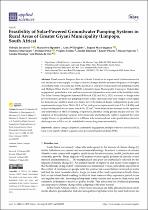| dc.contributor.author | Jovanovic, Nebojša | |
| dc.contributor.author | Mpambo, Mandelwa | |
| dc.contributor.author | Willoughby, Alana | |
| dc.date.accessioned | 2023-04-20T09:25:02Z | |
| dc.date.available | 2023-04-20T09:25:02Z | |
| dc.date.issued | 2023 | |
| dc.identifier.citation | Jovanovic, N. et al. (2023). Feasibility of solar-powered groundwater pumping systems in rural areas of greater Giyani municipality (Limpopo, South Africa). Applied Sciences, 13(6), 3859. https://doi.org/10.3390/app13063859 | en_US |
| dc.identifier.issn | 2076-3417 | |
| dc.identifier.uri | https://doi.org/10.3390/app13063859 | |
| dc.identifier.uri | http://hdl.handle.net/10566/8839 | |
| dc.description.abstract | Rural areas in Limpopo Province (South Africa) are in urgent need of interventions for
safe and secure water supply to adapt to climatic changes and the increased frequency of droughts.
A feasibility study was conducted for the adoption of solar-powered groundwater pumping systems
and Multiple Water Use Services (MUS) in Greater Giyani Municipality (Limpopo). Stakeholder
engagement, geotechnical data and socio-economic information were used in the feasibility study.
The Solar Powered Irrigation Systems (SPIS) tool (GIZ and FAO, 2021) was used to design solarpowered
shallow groundwater pumping systems at nine case study sites: four villages (water supply
for domestic use) and five small-scale farms. Given the technical design configurations, peak water
requirements ranged from 28.8 to 58.9 m3/d, peak power requirements from 1.2 to 3.4 kWp and
required solar panel surface areas from 8.0 to 22.3 m2. | en_US |
| dc.language.iso | en | en_US |
| dc.publisher | MDPI | en_US |
| dc.subject | Climate change | en_US |
| dc.subject | Groundwater | en_US |
| dc.subject | Geoscience | en_US |
| dc.subject | South Africa | en_US |
| dc.subject | Geography | en_US |
| dc.title | Feasibility of solar-powered groundwater pumping systems in rural areas of greater Giyani municipality (Limpopo, South Africa) | en_US |
| dc.type | Article | en_US |

